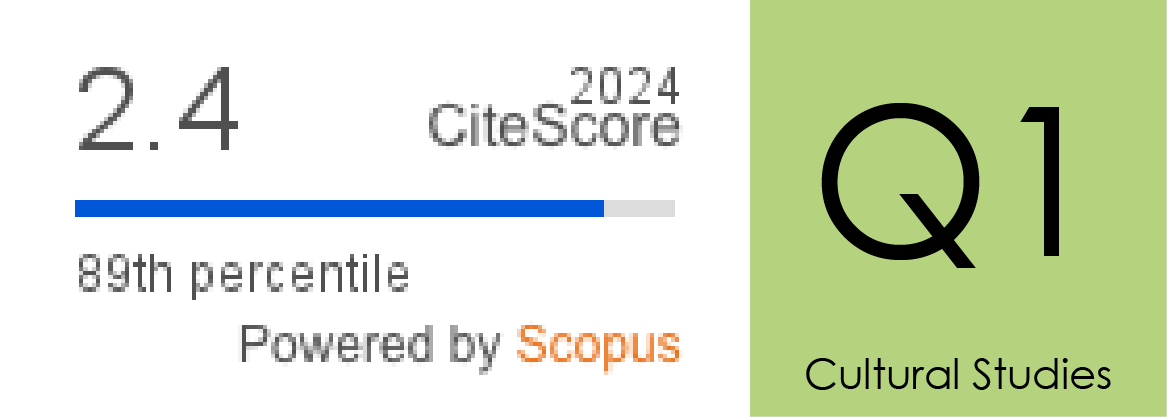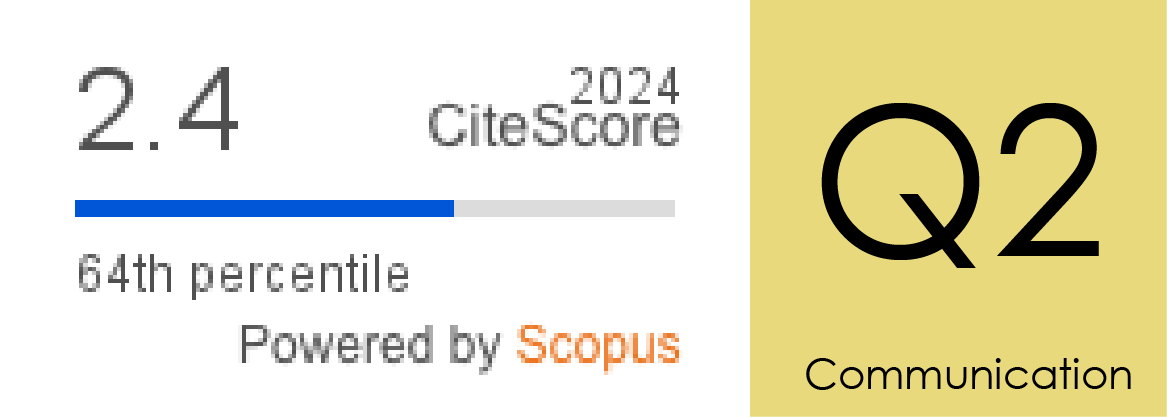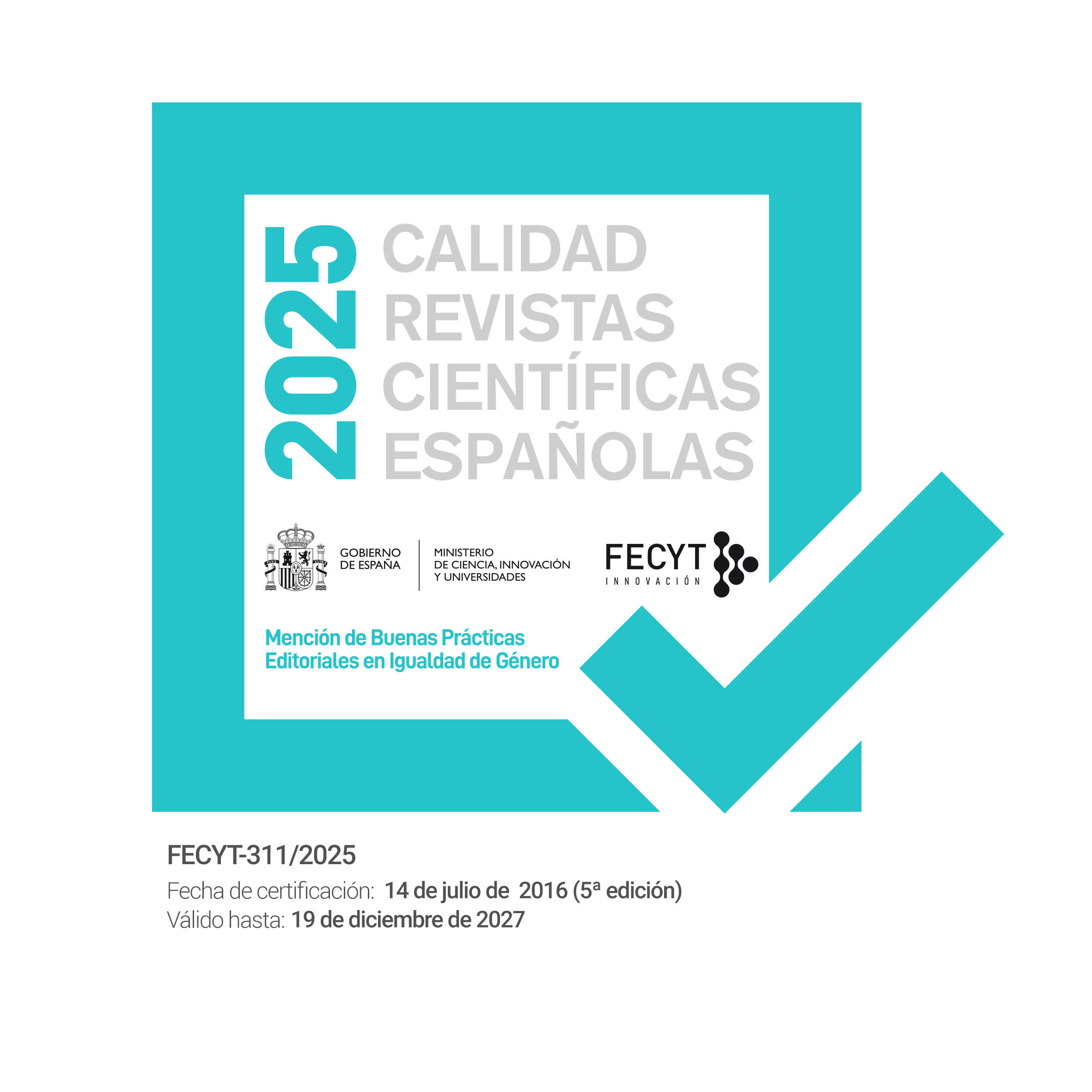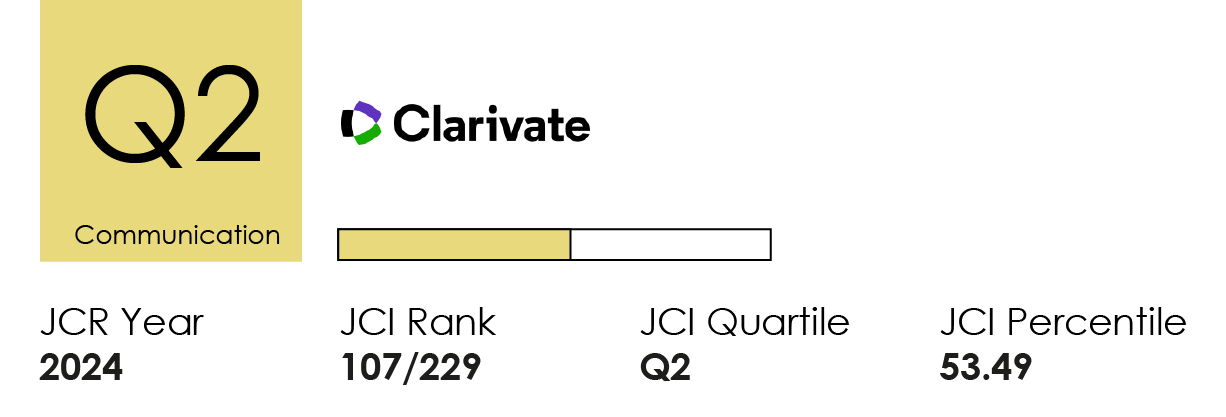Conflictos armados y perspectiva de género: Representación mediática de las niñas soldado
DOI:
https://doi.org/10.14198/MEDCOM000000Palabras clave:
niñas soldado, niños soldado, conflictos armados, perspectiva de género, cobertura mediática, representación mediáticaResumen
Naciones Unidas estima que globalmente hay 300.000 niños y niñas soldados en conflictos. Según dicha organización en 2018 el reclutamiento de niños y niñas aumentó en varios países como en la República Centroafricana y República Democrática de Congo, y alcanzó cifras alarmantes en Sudán del Sur y Somalia. Sin embargo, ni la literatura académica ni la cobertura mediática han dedicado espacio suficiente a esta grave problemática, en especial cuando se trata de representar en los medios la realidad de las niñas soldado desde el enfoque de género. Esta investigación aborda el estudio de caso de la representación de las niñas soldado en dos conflictos africanos: Sudán del Sur y República Centroafricana. Para ello hace un análisis cualitativo de la cobertura de dichos conflictos en dos diarios considerados quality press: The Guardian y Le Monde, entre 2011-2017. Los resultados mostraron que la presencia discursiva de niñas soldado en los artículos analizados es muy limitada en comparación a los niños soldados, con un encuadre predominante de víctimas de abusos sexuales, y no en el rol de combatientes supuestamente masculino, y sin apenas cobertura de noticias positivas como los procesos de rehabilitación de estas niñas.
Citas
Andsager, J. (2000). How Interest Groups Attempt To Shape Public Opinion with Competing New Frames. Journalism and Mass Communication Quaterly, 77(3), 577-592. http://doi.org/ctxwjx
Baas, S. (2011). From civilians to soldiers and from soldiers to civilians: A micro-approach to disarmament, demobilization, and reintegration (DDR) in Sudan. Universidad de Amsterdam: Países Bajos.
Blattman, C. & Annan, J. (2010). The consequences of child soldiering. The Review of Economics and Statistics, 92(4), 882-898. http://doi.org/c7dns5
Böhmelt, T. & Haer, R. (2018). Girl soldiering in rebel groups, 1989-2013: Introducing a new dataset. Journal of Peace Research, 55(3), 395-403. http://doi.org/gdj272
Brownell, G. & Praetorius R.T. (2017). Experiences of former child soldiers in Africa: A qualitative interpretive meta-synthesis. International Social Work, 60(2), 452-469. http://doi.org/f9x6qj
Carlsen, C. (2013). The voices of the invisible girls: Reintegration of former female child soldiers in Burundi. Universidad de Agder: Noruega. https://bit.ly/2WrMhVU
Child Soldiers International (2016). Des milliers des vies a reparer. https://bit.ly/3aVJMR2
Child Soldiers International (2018). In pictures: Meeting South Sudan’s returning girl.
Cole, A. (14/03/2012). Lubanga judgment marks milestone in the path towards accountability. The Guardian. https://bit.ly/3ddfxGM
Cotorcea, S. (2017). Reintegrating girls and boys formerly associated with armed forces and armed groups: A case study from Central African Republic (CAR). Save the Children. https://bit.ly/35u4CWx
Coulter, C.; Persson, M. & Utas, M. (2008). Young Female Fighters in African Wars: Conflict and its Consequences. NAI Policy Dialogue, Instituto Nordic Africa: Suecia. https://bit.ly/2xBRqCy
Curtis, P. & McCarthy, T. (08/03/2012). Kony 2012: what’s the real story?. The Guardian. https://bit.ly/35s3MJY
Denov, M. (2008). Girl soldiers and Human Rights: Lessons from Angola, Mozambique, Sierra Leone, and Northern Uganda. International Journal of Human Rights, 12(5), 811–833. http://doi.org/cgx2fz
Denov, M. (2010). Child Soldiers: Sierra Leone’s Revolutionary United Front. Cambridge: Cambridge University Press. http://doi.org/d9vfn7
Denov, M. (2012). Child Soldiers and Iconography: Portrayals and (Mis)representations. Children & Society, 26(4), 280-292. http://doi.org/bpr6zz
Ensor, M. (2012). Child Soldiers and Youth Citizens in South Sudan's Armed Conflict. Peace Review, 24(3), 276-283. http://doi.org/dqq4
Entman, R. (2004). Projections of Power: Framing News, Public Opinion, and U.S. Foreign Policy. Chicago: University of Chicago Press. http://doi.org/dqq5
Fairclough, N. (1992-1993). Discourse and Social Change. Cambridge: Polity Press.
Fouchard, A. (15/05/2015). Plus de 350 Enfants Soldats Libérés en Centrafrique. Le Monde.
Fox, M. J. (2004). Girl Soldiers: Human Security and Gendered Insecurity. Security Dialogue, 35(4), 465-479. http://doi.org/dkwjqd
Gamson, W. & Modigliani, A. (1989). Media Discours and Public Opinion on Nuclear Power: A Constructionist Approach. American Journal of Sociology, 95(1), 1-37. http://doi.org/cwz3w8
González-Aldea, P. (2014). El periodismo internacional en la era digital. Santa Cruz de Tenerife: Ediciones Idea.
Griffin, J. (31/07/2014). Killers to healers: training Burundi’s youth to choose peace. The Guardian. https://bit.ly/35tOaWl
Honwana, A. (2006). Child Soldiers in Africa. Philadelphia: University of Pennsylvania Press. http://doi.org/dtp9
IRIN (12/04/2012). DRC: Thorny Issue of Reparations for Lubanga’s Victims. The Guardian. https://bit.ly/3c4KpJd
Janier, A. (12/02/2012). Les Enfants Soldats Face au Défi de la Réinsertion. Le Monde. https://bit.ly/3c4KyML
McCombs, M. & Shaw, D. (1993). The Evolution of Agenda-Setting Research: Twenty-Five Years in the Marketplace of Ideas. Journal of Communication, 43(2), 58-67. http://doi.org/chqsbm
Macmillan, L. (2009). The Child Soldier in North-South Relations. International Political Sociology, 3(1), 36-52. http://doi.org/cvn3x5
McKay, S. (1998). The Effects of Armed Conflict on Girls and Women. Peace and Conflict: Journal of Peace Psychology, 4(4), 381-392. http://doi.org/bwh93w
McKay, S. (2005). Girls as “Weapons of terror” in Northern Uganda and Sierra Leonean Rebel Fighting Forces. Studies in Conflict & Terrorism, 28(5), 385-397. http://doi.org/fws7xr
Mazurana, D. (2005). Women in Armed Opposition Groups in Africa and the Promotion of International Humanitarian Law and Human Rights. PSIO, Geneva Call. https://bit.ly/2YyzXG0
Mazurana, D. & McKay, S. (2001). Child soldiers: What about the girls? Bulletin of the Atomic Scientists, 57(1), 30–35. http://doi.org/dtqb
Mazurana, D.; McKay, S.; Carlson, K. & Kasper, J. (2002). Girls in Fighting Forces and Groups: Their Recruitment, Participation, Demobilization, and Reintegration. Peace and Conflict: Journal of Peace Psychology, 8(2), 97-123. http://doi.org/b4d6j8
Naciones Unidas, Asamblea General. (1989). Convención sobre los Derechos del Niño, 44/25, (20 de noviembre, 1989). https://bit.ly/2Wp9PL7
Naciones Unidas, Asamblea General (1996). The Impact of Armed Conflict on Children: informe del experto del Secretario-General Sra. Machel Graça , A/51/306 (26 de agosto, 1996). https://bit.ly/35slwow
Naciones Unidas, Asamblea General (2002). Protocolo facultativo de la convención sobre los Derechos del Niño relativo a la participación de niños en los conflictos armados, A/RES/54/263 (12 de febrero de 2002). https://bit.ly/2SzdjJU
Naciones Unidas (2018). Los niños y los conflictos armados: informe por el Secretario-General, A/72/865 – S/2018/465 (16 de mayo, 2018). https://bit.ly/3dfY9RQ
Office of the Special Representative of the Secretary-General for Children and Armed Conflict (2018). Action Plan to Protect Children Signed in the Central African Republic. Nueva York. https://bit.ly/2Sz1EdX
Quian, A. y Elías, C. (2018). Estrategias y razones del impacto de WikiLeaks en la opinión pública mundial. Revista Española de Investigaciones Sociológicas, 162(91), 91-110. http://doi.org/dqq6
Rosen, D. (2005). Armies of the Young: Child Soldiers in War and Terrorism. New Brunswick, NJ: Rutgers University Press.
Smith, D. & Willsher, K. (05/12/2013). Clashes in Central African Republic as UN authorises French Intervention. The Guardian. https://bit.ly/3c3J6KO
Solman, P. & Henderson, L. (2019). Flood disasters in the United Kingdom and India: A critical discourse analysis of media reporting. Journalism, 20(12), 1648-1664. http://doi.org/dqq7
Spellings, C.R. (2008). Scratching the Surface: A Comparison of Girl Soldiers From Three Geographic Regions of the World. International Education, 38(1), 21-39. https://bit.ly/35tiX5q
Tassava, J. (2017). The Portrayal of Child soldiers in Documentaries and Hollywood Film. Butler Journal of Undergraduate Research, 3, 158-171. https://bit.ly/2WnchSk
Thomas, C.G. (2018). Secession and Separatism in Modern Africa. In M. Shanguhiya & T. Falola (Eds.), The Palgrave Handbook of African Colonial and Postcolonial History (pp. 729-757). New York, Estados Unidos: Palgrave Macmillan. http://doi.org/dqrb
United Nations Youth (2015). 4 out of 10 child Soldiers are Girls. https://bit.ly/2xuGBC2
Van Dijk, T. (2008). Discourse and Context: A Sociocognitive Approach. Cambridge: Cambridge University Press. http://doi.org/dqq48x
Vierge, R. (21/11/2013). Le Dr Mukwege, Infatigable Défenseur des Femmes Violées en RDC, Lauréat de la Fondation Chirac. Le Monde. https://bit.ly/3dfPZsx
Wessels, M. (2006). Child Soldiers: From Violence to Protection. Cambridge, MA: Harvard University Press.
Wodak, R. & Meyer, M. (2001). Methods of Critical Discourse Analysis. London: SAGE Publications.
Descargas
Estadísticas
Publicado
Cómo citar
Número
Sección
Licencia
Derechos de autor 2021 Laura-Yvonne Patiño-Gass, Patricia González-Aldea

Esta obra está bajo una licencia internacional Creative Commons Atribución-CompartirIgual 4.0.
Los autores y autoras que publican en esta revista están de acuerdo con los siguientes términos:
1 Derechos de autor. Los autores y autoras conservan sus derechos de autor, aunque ceden a la revista de forma no exclusiva los derechos de explotación (reproducción, distribución, comunicación pública y transformación) y garantizan a esta el derecho de primera publicación de su trabajo, el cual estará simultáneamente sujeto a la licencia indicada en punto 2. Los autores pueden establecer otros acuerdos adicionales para la distribución no exclusiva de la versión de la obra publicada en la revista, siempre que exista un reconocimiento de su publicación inicial en esta revista.
© Los autores.
2 Licencia. Los trabajos se publican en la revista sujetos a la licencia de Reconocimiento 4.0 Internacional de Creative Commons (CC BY 4.0); los términos se pueden consultar en https://creativecommons.org/licenses/by/4.0/
Esta licencia permite a terceros compartir (copiar y redistribuir el material en cualquier medio o formato) y adaptar (remezclar, transformar y crear a partir del material para cualquier finalidad, incluso comercial), siempre que se reconozca la autoría y la primera publicación en esta revista (Revista Mediterránea de Comunicación (RMC) / Mediterranean Journal of Communication (MJC), Universidad de Alicante, DOI de la obra), se proporcione un enlace a la licencia y se indique si se han realizado cambios en la obra.
3 Política de autoarchivo. Se recomienda a los autores que difundan sus trabajos a través de Internet para favorecer una circulación y difusión más rápidas y, con ello, un posible aumento en la citación y alcance entre la comunidad científica y académica, en las siguientes condiciones:
No se permite a los autores depositar en un repositorio institucional o temático, página web propia, etc., las versiones preprint (versión antes de ser evaluada) o postprint (versión evaluada y aceptada para su publicación) de sus trabajos antes de su publicación, pero sí el artículo final publicado (versión del editor).













